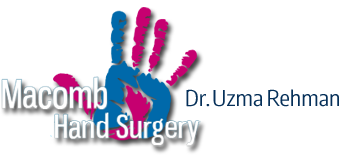Fall School Sports Can Results in Student Hand Injuries
School starts for most Oakland and Macomb County programs on September 8, 2021. A few Detroit area schools, however, are starting this week on August 31st.
As one of the Detroit area’s top hand doctors, we often observe an upsurge in students suffering sports-related injuries during the autumn athletic season. Football and volleyball are two prominent back-to-school activities that often result in hand, finger, and wrist injuries.
In the majority of sports, the athlete’s hand is often extended in front of him or her – and therefore receives the greatest contact, which results in hand, wrist or finger injuries.
Types of Student Sports Injuries
Acute traumatic injuries and chronic injuries are the two kinds of sports injuries.
Acute traumatic injuries are usually the consequence of a single strike, fall or impact. These can include bruising, fracture, sprain, strain, laceration, or abrasion.
Chronic sports injuries are those that develop over time due to repetitive motions or repeated stress.
Over time, chronic injuries may result in tendonitis, stress fractures, and apophysitis.
Apophysitis is an inflammation or stress injury to the areas on or around growth plates in children and adolescents. Apophysitis is usually caused by repetitive overuse activities like running, jumping, and throwing – but can also occur as an acute injury with a fall or rapid, powerful movement.
Most Common Types of Student Sports Injuries
Each year, a large number of high school football players seek treatment in hospital emergency rooms for hand injuries that result in a loss of more than three weeks of participation in sports.
The most often sustained football injuries include finger fractures, wrist tendinitis, and wrist sprains.
Hand and finger injuries are also very prevalent in both male and female student volleyball players. Volleyball injuries occurs most often when player sets, spikes, or blocks the ball – or when the volleyball collides with an athlete’s fingers.
Sprains, strains, fractures, contusions, and dislocations of the fingers/thumb are all common volleyball injuries. The thumb joint is the most often damaged hand ligament when playing volleyball. This injury is commonly referred to as a thumb sprain.
Treating Student Sports Injuries
Wrist sprains are muscle or tendon injuries that result in pain, swelling, soreness, warmth, and redness. The RICE technique of treatment is used. This stands for rest, ice, compression, and elevation.
Finger fractures can result in long-term mobility problems if not given enough time to recover. A finger fracture manifests itself via pain, swelling, discomfort, deformity, and the inability to fully move the finger. Treatments for student finger fractures include realigning the finger and immobilizing it with a splint or cast.
Wrist tendonitis is the swelling and irritation of the tissue around the thumb’s tendons. Typically, treatment consists of anti-inflammatory medicine and steroid injections. Surgery may be necessary in extreme instances.
Student Sports Injury Doctor
Fortunately, when treated by a sports injury specialist, the majority of student athlete hand injuries can be successfully treated with out long-term complications. Adolescents heal more rapidly than adults, and student athletes may generally resume physical activity fairly soon after recuperation.
Of course, many student athletic injuries are avoidable by wearing appropriates safety gear, doing strength and stretching exercises on a regular basis, warming up properly, and learning correct technique.
Student Sports Injury Doctor
Student Athletes should be taught not to play through discomfort or injury, since this may result in further harm. If your teen athlete experiences a hand or wrist injury, it is critical for them to avoid any physical activity until he or she can be seen by a hand specialist.
If your student athlete is suffering from any injury or pain in their fingers, wrist, elbow or arm, contact a sports injury doctor like Doctor Uzma Rehman for a comprehensive evaluation and consultation. As with most medical conditions, early detection, awareness, and a prompt and appropriate treatment plan is the most effective way to have a rapid recovery and avoid long term complications or mobility issues.
Doctor Rehman will assess your student athlete’s individual situation, and prescribe the treatments that are best for them – so they can get back to the activities they love as soon as possible.

